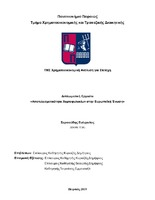Αποτελεσματικότητα χαρτοφυλακίων στην Ευρωπαϊκή Ένωση
Portfolio effectiveness in the European Union

View/
Keywords
CAPM ; Συντελεστής βήτα ; Ευρωπαϊκή Ένωση ; Αποτελεσματικότητα χαρτοφυλακίων ; Διαχείριση κινδύνου ; Απόδοση ; Διαστρωματική παλινδρόμηση ; Μοντέλο δύο παραμέτρων ; Υπόδειγμα της αγοράςAbstract
The main purpose of this study is the portfolios’ composition and the test of their effectiveness in European Union’s market, using as sample three countries-members of the EU, Greece, France and Great Britain. The period under consideration is a period of 19 years, from the beginning of 2000 to the end of 2018, which is degraded into six sub-periods of three years each and the seventh is composed of the observations of 2018, in order to accomplish the cross-sectional inspection of the performance of the created portfolios. Numerous bibliographies constituted a pretty strong theoretical basis, and as tools the CAPM and the two-parameter regression of Eugene F. Fama and James D. MacBeth (1973). The sample data on which this paper was based are the daily logarithmic yields both the shares of the three countries and the market index of each country. The methodology followed, based on the earlier study by Eugene F. Fama and James D. MacBeth (1973), analyzed and investigated the data according to the assumptions, to determine the effectiveness of portfolios, the relationship between risk and return and the potential impact of risk on average returns on portfolios. Results vary across the three countries, reflecting the three different versions of the economy in response to the 2008 financial crisis, and the behavior of the shares of the three countries in general, not allowing us to deduce a single conclusion for each country separately. The results we conclude are that the portfolios we have created can be effective in all three countries, but both the Market Model and the effect of risk on average returns on portfolios differ either from country to country or between the sub-periods under consideration.


